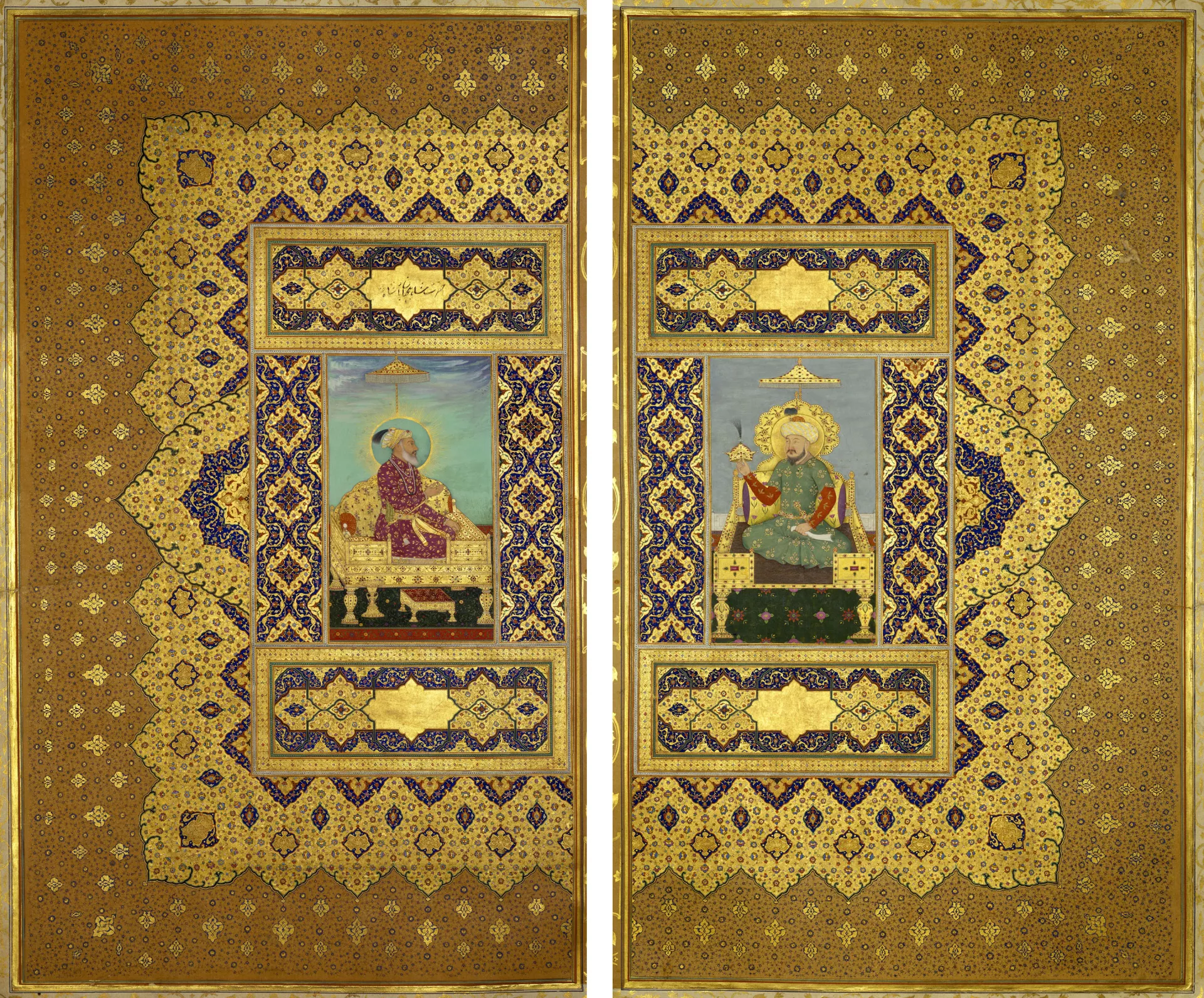
Eastern Encounters
Drawn from the Royal Library's collection of South Asian books and manuscripts
Illuminated frontispiece with portraits of Timur and the Mughal Emperor Shah-Jahan
Mughal, <i>c</i>.1657Fols 2v and 3r from a manuscript of the Padshahnama (see cat. no. 26) | 2v: Painting in opaque watercolour including gold metallic paints with decorative incising on brown paper; set into margins of gold metallic paint on paper with black ink inscription 3r: Painting in opaque watercolour including gold and silver metallic paints with decorative incising and black ink on brown paper; set into margins of gold metallic paint on paper with black ink seal impression | 57.9 × 36.6 cm (folio); 45.8 × 26.1 cm (panel); 58.1 × 36.8 cm (folio); 46.0 × 26.3 cm (ruled panel) | RCINS 1005025.d and 1005025.e
This superbly illuminated frontispiece contains portraits of the Mughal progenitor Timur (1336–1405) and Emperor Shah-Jahan (r. 1628–58), both seated on magnificent golden thrones inlaid with precious stones. The term ‘Mughal’ (a corruption of ‘Mongol’) is in fact a European misnomer for the dynasty that considered itself ‘Timurid’. When the two pages are read together, from right to left, the images imply that Timur, the great ruler of Central Asia, is passing the imperial Timurid crown to Shah-Jahan. The Mughals’ prestigious dynastic heritage was a major element in their assertion of political legitimacy in the subcontinent, and the Padshahnama’s introduction includes a long discourse on the Emperor’s imperial genealogy from Timur.[97]
As an overt dynastic reference, Shah-Jahan adopted Timur’s ceremonial title Sahib-Qiran, ‘Lord of the Auspicious Conjunction’, calling himself Sahib-Qiran-e Sani (‘Second Lord of the Auspicious Conjunction’). This ‘auspicious conjunction’ refers to the alignment of Jupiter with another planet which happened to occur at the time of both rulers’ births – with Saturn for Timur and Venus for Shah-Jahan. According to Islamic astrology, these very rare conjunctions indicated events of universal consequence, particularly a change or transfer in royal authority.[98] Astrological tables and birth charts illuminated in gold were included within the Padshahnama text to signify the auspicious timing of both rulers’ entry into the world.[99]
Shah-Jahan is depicted as an elderly man with a long white beard, dating the paintings to the late 1650s. The portrait of Timur is probably based on a painting of c.1630 by the artist Govardhan[100] – the work’s formality and crispness, unusual for the mid-seventeenth century, appears to be conscious historicising on the part of the artist to articulate the different time period.
hazrat-e shahjahan padshah / His Majesty the Emperor Shah-Jahan
[97] See Ballinbar 2015 and Moin 2012.
[98] Ibn Khaldun’s Muqaddimah, quoted in Moin 2012, p. 30.
[99] RCIN 1005025, fols 9r–13v and 56r–59v: see Baburi 2012, p. 141, notes 9 and 10.
[100] Timur, Babur, Humayun, c.1630 (V&A IM.8-1925), possibly intended as a pair to Akbar, Jahangir, Shah-Jahan, by Bichtir, dated 1630–1, in the Minto Album (CBL In 07A.19).
Bibliographic reference(s)
Beach and Koch 1997, pp. 24, 159








